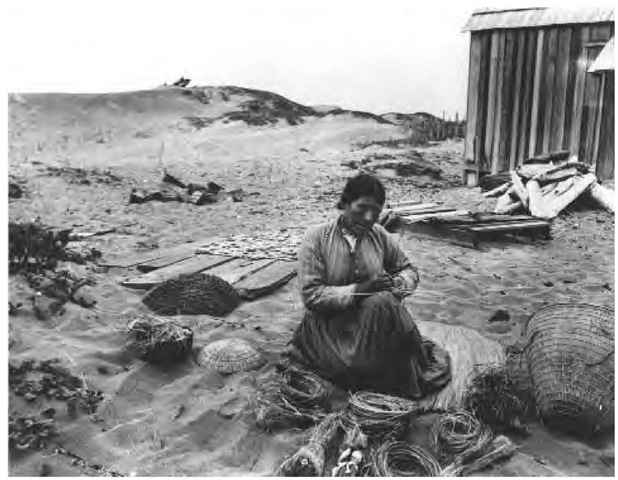Wiyot is the name of one of three culturally and linguistically related groups on the Eel River Delta in the early nineteenth century. They were culturally similar to the Yurok.
Location The Wiyot traditionally inhabited the vicinity of Humboldt Bay, California, from the Little River south to the Bear River and east about 25 miles. This environment is coastal lowlands, an unusual one in California. Today, most Wiyots live in and around Humboldt County.
Population As many as 3,500 Wiyot may been living in their region in the early nineteenth century. In 1990, roughly 50 Indians who consider themselves Wiyot lived on rancherias, with perhaps another 400 in local cities and towns.
Language Wiyot was an Algonquian language related to Yurok.
Historical Information
History Humboldt Bay was first occupied around 900 by either Wiyots or Yuroks. In 1806, the first non-native explorers came into the region. The first systematic murders of Wiyots began around 1852 during the Chetco/Rogue River Indian War. Regular killings of Indians led to wholesale massacres shortly thereafter. In 1860, a massacre at Gunther Island,perpetrated by white residents of Eureka during a Wiyot religious celebration, killed as many as 250 Indians. Survivors were forced onto reservations on the Klamath and Smith Rivers. Wiyot culture never recovered from this event; their identity became mixed with whites and other local Indian peoples.
Religion The creator was known as "that old man above." The Wiyot practiced World Renewal ceremonies and dances. Although other peoples celebrated the World Renewal religion in a showy and complex manner, which involved recitations, displays of wealth, costumed dances, and various decorations, the Wiyot observed it irregularly and with less flair. Men and women also performed victory dances when an enemy was killed and conducted an elaborate girls’ puberty ceremony. They did not observe a first salmon ritual. Female berdaches played an important role in Wiyot ceremonialism.
Government In place of formal tribal organization, each Wiyot group was autonomous and self-governing.
Customs Wealth was valued as the source of social stratification and prestige, although not to the degree of the Klamath River peoples. There was no debt slavery. Most of the common menstrual taboos were absent among the Wiyot. Married couples generally lived with the father’s family, except in the case of "half-marriages" (when a man worked to cover part of the bride price). Corpses were carried by stretcher to the cemetery and buried in an extended position in plank-lined graves along with money and valuables. Relatives and undertakers observed various taboos following the funeral.
Both women and men hunted. Disease was considered to be caused either by the intrusion of poison objects, soul loss, or breaches of taboo. Herb doctors and especially sucking doctors (shamans) cured disease. Unlike most northwest California peoples, the Wiyots did not penalize shamans for declining a curing case.
Dwellings Two or more families, including men, slept in rectangular houses of split redwood planks. Each unnamed house had a two- or three-pitch roof and a smoke hole at the top. The sweat house, built like a dwelling, only smaller, was used for gambling, ceremony, and occasionally sleeping. The Wiyot built no separate birth or menstrual huts.
Diet Acorns were both traded for and gathered on special inland expeditions. The people also gathered berries and various other foods. Salmon, the main food staple along with other fish, was caught with traps, nets, weirs, on platforms, and with the use of fish poisons. Other foods included mollusks, sea lions, stranded whales, deer, elk, and other game. They did not eat wolf, fox, bear, and skunk.
Wiyot baskets were particularly well made, and women generally wore twined basket hats. This Wiyot woman is basket weaving in the dunes near Eureka in 1900.
Key Technology Tools and utilitarian items were made from bone, shell, stone, and wood. Twined baskets served a large variety of purposes.
Trade Wiyots participated in a regional trading complex.
Notable Arts Wiyot baskets were particularly well made.
Transportation The Wiyot used large redwood dugout canoes.
Dress Women generally wore twined basket hats and either fringed and embroidered buckskin double-aprons that hung to between the knee and the ankle or one-piece, inner-bark skirts or aprons. Men wore buckskin breechclouts. Robes were of deer hide and woven rabbit skin. Both sexes wore moccasins.
War and Weapons Murder, insult, or poaching were the typical causes of war. The Wiyot fought by surprise attack or prearranged battle and used elk hide armor, rawhide shields, and bows and arrows. Women and children were not killed in war. After the fighting, both sides paid compensation for damaged property.
Contemporary Information
Government/Reservations Today, Wiyot live on the Blue Lake Rancheria (Wiyot, Yurok, Hupa; Humboldt County), the Rohnerville Rancheria (Wiyot-Mattole; Humboldt County), the Table Bluff Rancheria (Humboldt County), and the Trinidad Rancheria (Yurok, Wiyot, Tolowa; Humboldt County). Government is by tribal council.
Economy All four rancherias are working to promote economic development. Logging and fishing are important economic activities.
Legal Status The Bear River Band of the Rohnerville Rancheria is a federally recognized tribal entity (Wiyot/Mattole). The Blue Lake Rancheria, the Trinidad Rancheria, and the Table Bluff Rancheria are federally recognized tribal entities.
Daily Life The Wiyot support the traditional culture of their neighbors. They also hold an annual vigil in memory of the victims of the 1860 massacre. There is some semitraditional basket making among the people.

